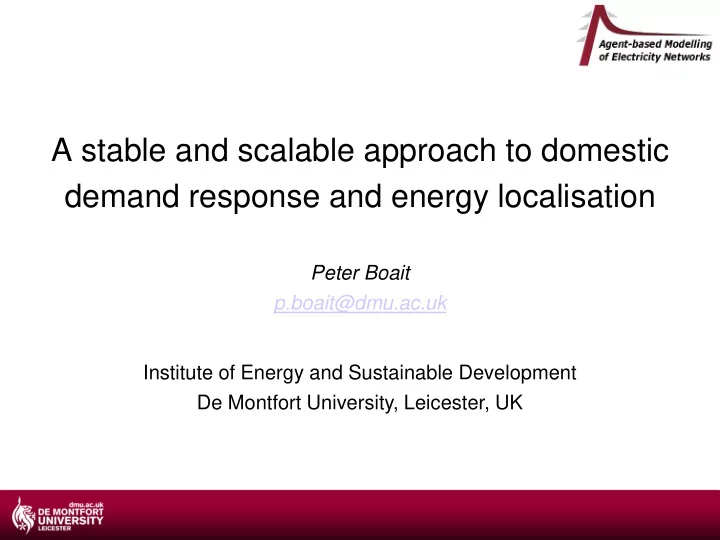

A stable and scalable approach to domestic demand response and energy localisation Peter Boait p.boait@dmu.ac.uk Institute of Energy and Sustainable Development De Montfort University, Leicester, UK
Today’s domestic demand response solution – Economy 7 and Radio Teleswitch • Too bossy – direct control of space heating and hot water • Limited tariff options • Limited scalability • Not adaptable to electric cars, heat pumps, etc. etc • BUT has provided a valuable service for 30+ years • Good feature is that few people know they have one! So a replacement must: • Ensure user needs and comfort are met as a priority to gain trust and engagement • Support “gapping” response (heat pump, cold appliances ); • Support time window bounded response (wet appliances, factory processes, electric car charging) • Offer commercial flexibility to satisfy all UK electricity market stakeholders • Be scalable to 100M+ devices and 1000s of electricity suppliers (e.g. local co-ops)
Dynamic time- dependent pricing creates feedback paths and risks to system stability
Evolution of Economy 7 into a multi-level dynamic time of day tariff is a bad idea because: • Demand moves to the cheapest and/or most convenient timeslots • Peak-to-mean ratio gets worse rather than improved • System stability is degraded – loop gain of feedback path can exceed 1 leading to oscillation.
Demand Shaper solves this problem with a 3-element system • A 48- value daily signal that looks like a tariff but doesn’t have to be one – allows complete commercial flexibility for electricity suppliers • A smart home control unit that responds with a biased random assignment of demand to timeslots within a time window that meets user’s needs. The bias responds to the shape of the signal, the random assignment ensures no peaks. • A method which allows the supplier to learn the demand flexibility available within their customer base from half-hour metering and construct the signal so that demand is shaped to any desired profile within the flexibility available.
The complete Demand Shaper system Signal to obtain demand Smart meter “Smart home” response collecting half Electricity control unit hourly supplier consumption Half hourly meter data Wholesale User electricity inputs market Controlled appliances, heating, etc.
Biased random assignment of demand by the smart home control unit means: • Signal S is interpreted as a scale for each timeslot that attracts or repels demand – we normalise it as ranging from +1 (most repellent) through 0 (indifferent) to -1 (most attractive) • Assume user needs immersion to heat their hot water sometime within 4 timeslots with signal values of 0.5, 0.25, 0, -0.25. • Controller takes 1- S i for these to give attractiveness values 0.5, 0.75, 1, 1.25, sum = 3.5 • Probability of heating going on for each timeslot is 0.5/3.5 etc. = 0.14, 0.21, 0.29, 0.36 • So over a population of hot water tanks demand is assigned in proportion to attractiveness of the signal. • So over all appliances there is an approximately linear relationship between the signal S and demand response d B of the form but with different constants for each d B S k B c i i i i i timeslot and positive or negative values of S i
So demand becomes predictable and adjustable with this kind of relationship between demand and the signal in each timeslot: • X axis is normalised signal value multiplied by the baseline demand. • Y axis is the change from baseline demand that results from the given signal value*baseline product
Electricity supplier’s shaping method • An electricity supplier with a population of consumers equipped with this technology can build a model of the demand profile D obtained in response to S in the form of 96 linear equations: D B ( 1 S k ) c i i i i i • A suitable signal S can then be found for any desired D within the available flexibility of consumer demand using non-linear optimisation (e.g. active set or Nelder- Mead). A “flattening” signal is given by: Build demand Determine desired Determine Transmit S to response model demand profile D and baseline demand smart device from simulation required signal S by profile B population and trials optimisation
Distribution network challenge - possible domestic demand baseline in 2020+ B D - 1000 homes all heated by heat pump, 25% have electric vehicles - Substantial winter demand from heat pump - Electric vehicles increase size of early evening peak - Demand flattened using demand shaping and optimised signal
50- home trial in Oxfordshire of “Hestia” smart controls under Innovate UK “Localised Energy Systems” call Replace this kind of control With this • Will exploit energy storage in storage heaters, batteries, and water tanks • Will allow users to defer demand of wet appliances • Demand will be shaped across the community to make best use of 54kW of PV and respond to electricity supplier’s needs
Conclusion - Dynamically variable tariffs particularly when combined with cost-minimising smart home devices have undesirable side effects, and may not be acceptable to regulators - It is possible to flatten demand and shape it to match available supply using a signal that does not directly indicate price - Requires smart home control unit with biased random assignment algorithm - Our trial (partners Oxford ECI and Co-Op Energy inter alia ) will translate agent based modelling into real life!
Recommend
More recommend